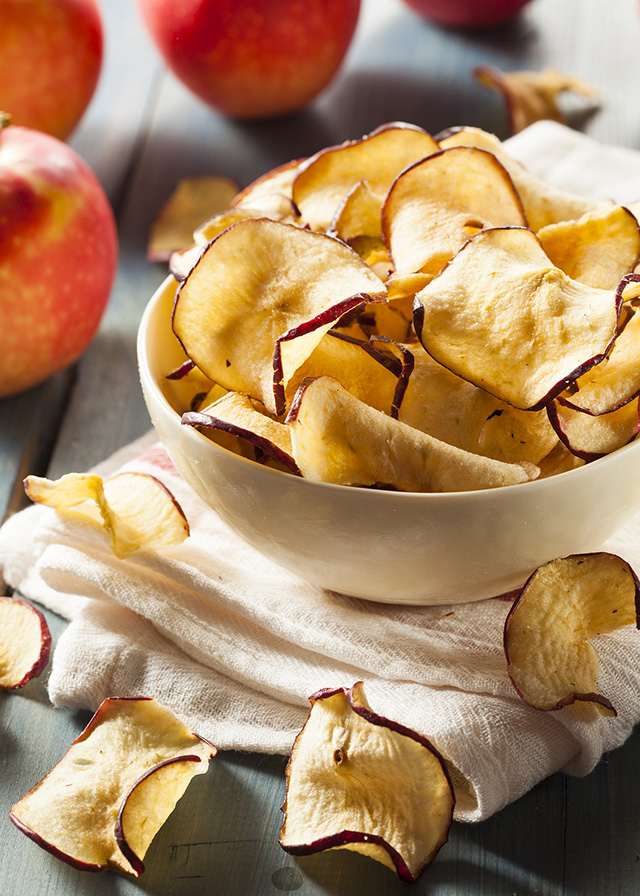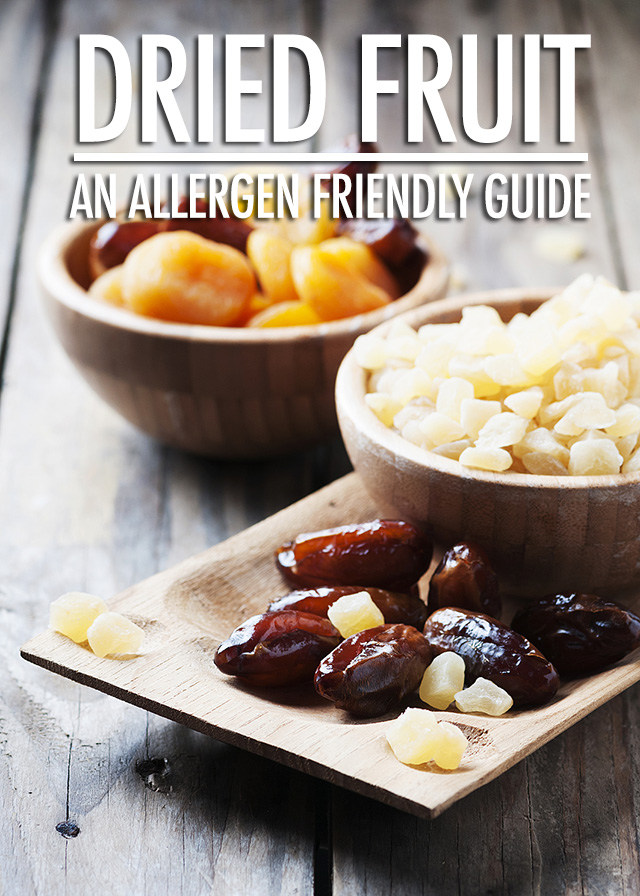What do you do when you’ve been diagnosed with a food allergy and your favourite foods are taken away? Fear not! Each month FBC member and certified nutritionist, Sondi Bruner, takes a look at how to adapt to an allergen-friendly diet, while still eating delicious and healthy food. This month she examines the allergy and health considerations of dried fruit.

Dried fruit is an ingredient we probably don't think about when we consider allergy risks. After all, it's just fruit that's had the moisture sucked out of it, right?
Not always, unfortunately. In today's column, I'll walk you through some the allergy and health considerations you may want to be mindful of when using dried fruit or cooking for someone with an allergy.
Dried Fruit and Gluten-Intolerance/Celiac Disease
If you're serving food or desserts to people with celiac disease or a gluten intolerance, be aware dried fruits may be contaminated with sources of gluten. Some companies that sell dried fruits coat them with glutenous flours so they don't stick together. You probably won't be able to see the flour with the naked eye, but the presence of flour is enough to trigger a reaction in someone who is gluten intolerant or has celiac disease. It's typically a good bet to ask the grocery store manager or call the company to double check if flours or another glutenous ingredient were used.
Also, if you purchase from bulk bins someone else may have accidentally used a scoop from another bin with a glutenous product and then left it in the dried fruit. So even if the fruit in the bin was initially gluten free, the contaminated scoop tainted the whole thing. Whenever possible, I like to buy from the vertical bins where you have to pull a lever to release the bulk goodies; that way, you don't have scoops coming and going willy-nilly.
Dried Fruit and Mould
Dried fruit can support mould and yeast growth, and this can lead to the production of mycotoxins. Mycotoxins are compounds that can impact our immune health, and potentially cause gastrointestinal distress and influence liver, kidney and carcinogenic diseases. Some moulds may cause respiratory or skin symptoms as well.
Shipping, handling and storing can impact mould growth on foods. Here in Canada, the government monitors our food supply and sets maximum allowable levels for mycotoxins. Once you buy them, ensure you store dried fruits properly in airtight containers and stash in a cool, dark place (you can also check out this post from Well Preserved for more dried fruit storage and handling tips).
Check your dried fruit for any visible signs of mould and note any strange odours, discolouration or a change in texture. When in doubt, just throw it out! Also, don't just scrape off the mouldy bits; if mould is showing up in one part of your dried fruit, it will likely have infiltrated the whole thing.
Dried Fruit and Sulphites

Sulphites are a preservative used on dried fruit — as well as many other foods and beverages — to extend shelf life. The sulphites found on dried fruit are linked to a range of effects, including itchy skin, hives, stomach pain, diarrhea, asthma and even anaphylaxis.
The government requires food companies to list suphites on packaging, so be sure to check labels if you or someone you know is sensitive to them.
Dried Fruit and Blood Sugar
Since most fresh fruit is already naturally sweet, when you remove the water what you're left with are highly concentrated nuggets of sweetness and fibre. While fibre can help to slow down blood sugar, you're still consuming a lot of sugar and it's important to be mindful of how much dried fruit you eat. It's much easier to guzzle a dozen dried apricots than to eat a dozen fresh ones in one sitting, right?
Some dried fruit manufacturers coat their products with extra sugar, maple syrup or fruit juices to make them even sweeter, or to make them more palable in some cases. Take dried cranberries, for instance. Cranberries are incredibly sour when fresh, while the dried versions are often more sweet than tangy.
You may also want to make a note to drink more water if you've been snacking on dried fruits, or rehydrate dried fruits for a few minutes in warm water before using them so your digestive tract doesn't need to pull additional water to rehydrate them. Remember, dried fruit is high in fibre, and fibre needs water to move through your system efficiently.
How To Use Dried Fruit
Dried fruit can be used in your diet in a multitude of ways, including:
- In smoothies
- To top cereals or porridge
- In trail mix
- On its own as a snack
- In baked goods
- To top salads
- As a natural sweetener: date paste or prune paste are great in recipes!
Make Your Own Dried Fruit!

Drying fruits is a great way to preserve them, especially if you've got a large amount on hand and have already made jam and frozen several containers worth in the freezer.
You can use a food dehydrator if you have one, or dry them out in 4 to 8 hours in the oven. My two favourite things to make are fruit leather and apple chips. Fruit leather is super easy: puree your fruit in a food processor or blender, then spread it out to dry in your dehydrator or on parchment in the oven. For apple chips, I slice them thinly and sprinkle with cinnamon (you could also add dried ginger or nutmeg), then bake in the oven until they're dry. Great for fall apple season!
Storing Dried Fruit
Dried fruit should be stored in a cool, dark place in an airtight container and can last for several months like this. You can also store them in airtight glass containers that can look really pretty on your counter or pantry shelves but exposure to light will shorten the shelf life of your dried fruit so be sure to use them up quickly if you do that.
You can also store dried fruit in the freezer if you want to keep it longer. It can last up to a year like this.
How do you like to use dried fruit in your everyday cooking? Please share in the comments!
More Reading
Check out more of Sondi’s Allergen-Friendly Guides and Recipe Remixes for great ideas on revamping your favourite recipes to make them allergen friendly!
- A Guide to Dairy-Free Milks
- Edible Gifts
- Vegan and Gluten-Free Pies and Tarts
- Gingerbread Cookies
- Holiday Stuffing
Sondi Bruner is a holistic nutritionist, freelance writer, food blogger and author of the Anti-Inflammatory Diet in 21, The Candida Free Cookbook and Action Plan, co-author of The Anti-Inflammatory Diet and Action Plans as well as multiple e-books on healthy eating. She educates people who follow allergen-friendly diets about how to eat simply, deliciously and safely, allowing them to rediscover the pleasure of food. When she’s wearing her writer’s hat, she works with natural health brands to create content that will help their customers live fulfilling, healthful lives. Find out more at www.sondibruner.com. Or you can follow Sondi on Facebook or Twitter.









Oh wow, didn’t know about flour coating and some other interesting facts in the article. Thanks for sharing all this information as I use dry fruit in cooking a lot and also love eating t as a snack